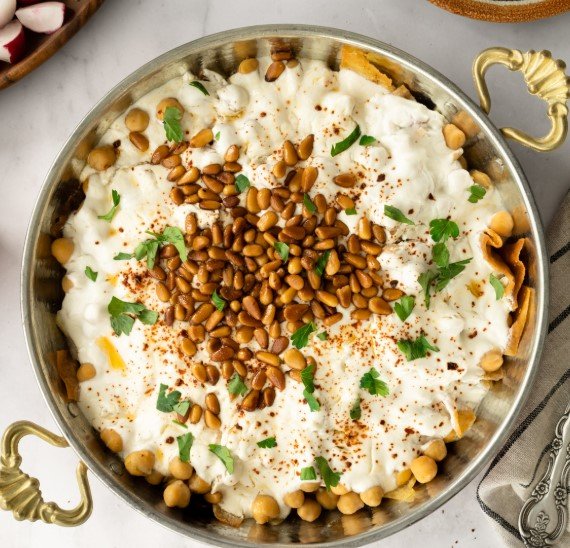From frugal roots to modern feasts, this layered dish of bread, yogurt, and spice captures the soul of Middle Eastern cooking
Some dishes need a recipe. Fatteh just needs a story—and something crunchy.
At first glance, it’s humble: toasted bread, warm chickpeas or eggplant, a drizzle of yogurt, and a final punch of fried nuts. But don’t be fooled. This isn’t just dinner. It’s a whole philosophy of how to cook with heart, history, and what you’ve got in the pantry.
Across Arab kitchens from Palestine to Egypt to Syria, fatteh has long been more than food. It’s a lesson in generosity, survival, and flavor that hits like a drum. And now, it’s quietly showing up on more menus, cookbooks, and Instagram feeds than ever before.
Where It All Began: Bread, Scarcity, and Resourcefulness
Fatteh didn’t start in luxury. It started in necessity.
Bread was always there—too precious to waste, too dry after a few days to eat on its own. So families started layering it with whatever they had: broth, legumes, yogurt, or lamb.
The result? A filling, shareable meal that could stretch for miles.
In Arab tradition, guests are honored. You feed who comes. And fatteh became the perfect thing to pull together on short notice. You didn’t need a shopping list — just a pot, a pan, and a plan.
Now, the same dish that was born out of frugality sits front and center during Ramadan feasts and holiday celebrations.
One line: It’s what you cook when there’s not much — and what you serve when there’s everything.

What’s in a Fatteh? Depends on Who’s Asking
Here’s the fun part: there’s no single “correct” way to make fatteh. There are hundreds, maybe thousands.
A quick scan across the Levant reveals just how creative this dish can get:
-
In Palestine, it might come with spiced ground lamb, golden pine nuts, and garlicky yogurt.
-
In Egypt, it leans toward beef broth, rice, and vinegar.
-
In Lebanon, you’ll find versions bursting with eggplant and tahini.
-
In Jordan, it’s often chickpeas, yogurt, and a heavy pour of clarified butter.
All of them start the same way — with stale bread. But what happens next depends on the region, the fridge, and the cook.
The Anatomy of Fatteh: Layers That Matter
Even though variations abound, there’s a general structure that most fatteh dishes stick to.
Here’s a quick breakdown:
| Layer | Purpose | Common Ingredients |
|---|---|---|
| Base | Crunch, absorbency | Fried or baked pita bread |
| Warm layer | Protein, heartiness | Chickpeas, braised lamb, eggplant |
| Sauce | Cool, tangy contrast | Yogurt, garlic, lemon, tahini |
| Topper | Final crunch + flavor burst | Nuts, parsley, sumac, pomegranate seeds |
Each spoonful is a flavor bomb: soft against crisp, cool against warm, mild chickpeas versus garlicky yogurt. And don’t skip the ghee drizzle — that final pour of fat ties everything together.
Why It’s Going Global — And Why That Matters
In the last year alone, fatteh has shown up on the menus of modern Arab restaurants in London, Brooklyn, Berlin, and Sydney. Chefs are getting playful — adding mushrooms, salmon, even truffle oil. Some purists flinch. Others don’t mind.
For cookbook author and writer Reem Kassis, who’s helped champion Palestinian dishes in the West, fatteh’s rise is long overdue. “It’s a dish that speaks to how Arabs think about food,” she wrote. “It’s about sharing, layering, improvising.”
Foodies love it because it’s textured and complex. Cooks love it because it’s adaptable and cheap. And Arab communities love that their comfort food is finally being seen.
Still, there’s caution.
Some worry fatteh might be stripped of its roots, turned into just another trend without credit to the cultures that made it.
One line: It’s not just a dish — it’s identity in a bowl.
How to Make It at Home Without a Fuss
You don’t need to be Arab. You don’t need fancy ingredients. Just follow the spirit of fatteh.
Here’s one foolproof starter version:
-
Step 1: Toast or fry pieces of old pita until golden and crunchy. Spread them in a wide dish.
-
Step 2: Warm up some canned chickpeas with salt, cumin, and a touch of broth. Pour them over the bread.
-
Step 3: Mix plain yogurt with minced garlic and lemon juice. Dollop generously on top.
-
Step 4: In a small pan, heat butter or ghee with slivered almonds or pine nuts until golden. Pour over everything.
-
Optional extras: Sprinkle with parsley, sumac, paprika, or pomegranate seeds.
Serve immediately. The contrast — crunchy bread soaking up warm broth, cold yogurt hitting hot chickpeas — is the magic.
And don’t wait for a holiday. Fatteh is perfect for lunch, midnight snacks, or feeding five people on a budget.
A Dish That Never Stands Still
Fatteh isn’t frozen in time. It grows, shifts, and stretches wherever it’s cooked.
One cook uses fried eggplant. Another swears by pickled turnips. Someone else mixes in lentils and garlic chips. And it all counts. Because fatteh was never about precision. It was always about presence — what’s available, what feels right, what honors the table.
In a world obsessed with exact measurements and perfect plating, fatteh offers something softer, looser, and maybe more honest.
